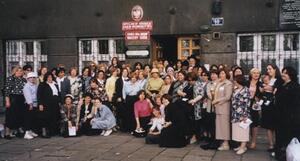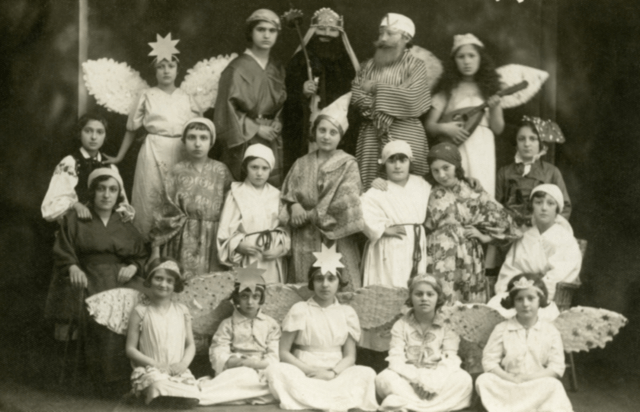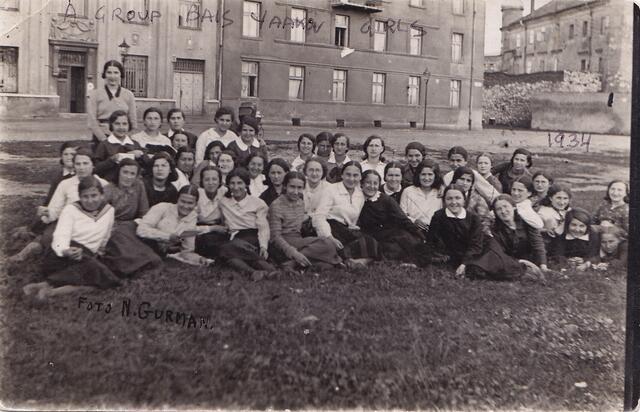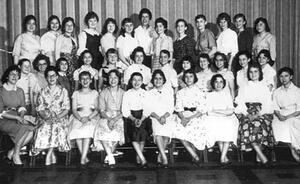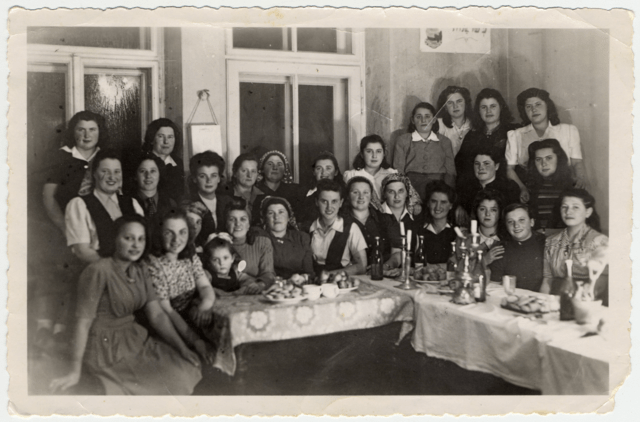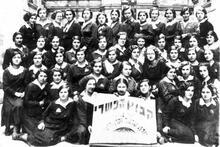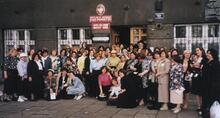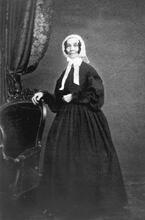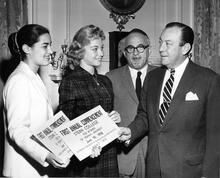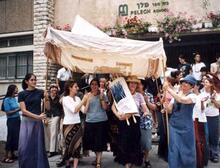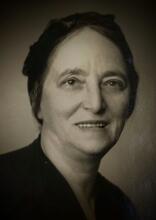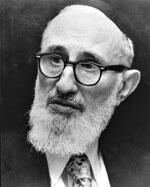Bais Ya'akov Schools
"Frau Schenirer, we are not merely placing a memorial on your grave site. We are placing it upon our hearts: for us, and for all the generations who will come after us." Bais Ya’akov students and teachers from around the world attended the 2005 re-dedication ceremony of Sarah Schenirer’s gravestone, and with these words, the director of the Central Bais Ya'akov in Jerusalem eulogized the woman to whom all had come to pay their respects.
Institution: Devorah Sandorfy Sabag, Jerusalem
Bais Yaakov is a network of schools and youth movements for Orthodox girls, founded in 1917 by Sarah Schenirer, who sought to provide girls with the religious education that had been denied them and thus reverse the mass defection of girls from Orthodoxy. After its 1923 adoption by the Agudat Israel, the political organization of world Orthodoxy, the movement grew to hundreds of schools in Poland and beyond, and it continues to thrive in thirteen countries today, with major centers in North America and Israel. In the interwar period, Bais Yaakov had a pioneering and revolutionary character, borrowing from Hasidism, the yeshiva, socialism, feminism, Zionism, and secular youth movements. After the Holocaust, Bais Yaakov became more conservative, even as it cherishes its revolutionary beginnings.
Founded by Sarah Schenirer as a way of combating assimilation among her contemporaries, Bais Yaakov is an Orthodox Jewish educational movement for girls and young women that began in Krakow, Poland, in 1917 and spread rapidly throughout much of the Ashkenazi Jewish world.
Traditional Education for Jewish Girls
Since the commandment of Torah she-bi-khetav: Lit. "the written Torah." The Bible; the Pentateuch; Tanakh (the Pentateuch, Prophets and Hagiographia)Torah study is not incumbent on women (and, according to some sources, may actually be forbidden), there had not been a tradition of formal schooling for girls within the Jewish community. Instead, they were trained at home, usually by their mothers and other female relatives, for the largely domestic roles they would be fulfilling as adult Jewish women. By the second half of the nineteenth century, as economic conditions in Eastern Europe deteriorated, it became necessary to send girls to school to acquire the linguistic and vocational skills necessary to support a family. There was also pressure by governmental forces to educate Jewish children in non-religious venues. As a result, many observant Jewish parents began to send their daughters to non-Jewish and sometimes even Catholic schools, where they were exposed to secular literature and anti-traditional cultural and social trends, including a nascent form of feminism. This exposure caused many of them to question and even abandon the traditional structures of family and community within which they lived. In 1903, at a rabbinical conference in Krakow, a suggestion was made to establish Orthodox schools for girls, in order to keep them “within the fold,” but this suggestion was rejected as being too radical an innovation.
Establishing a New System
It took fourteen years, World War I, and a courageous and dedicated dressmaker—Sarah Schenirer—to change the situation. During the war Schenirer lived in Vienna and was influenced by the Western European movement known as Neo-Orthodoxy, whose founder, Rabbi Samson Raphael Hirsch (1808–1888), had established schools for girls in Germany in the nineteenth century. Upon her return to Poland, Schenirer began to organize lectures and a lending library for young women. Realizing that, in order to be effective, educational activity would have to begin at a much earlier age, Schenirer opened a kindergarten, primarily with the daughters of her customers. She received the blessing of the Belzer Rebbe (Issacher Dov of Belz, 1845–1927) for her endeavor, although he later forbade daughters of Belzer A member of the hasidic movement, founded in the first half of the 18th century by Israel ben Eliezer Ba'al Shem Tov.Hasidim to attend.
The movement grew, its major power base being the Gur branch of Hasidism. Rabbi Israel Meir Ha-Kohen (1838–1933), better known by the title of one of his major works, the Hafez Hayyim, later gave rabbinic approval to the deviation from tradition represented by the establishment of girls’ schools within the Orthodox community, on the grounds that the defection of Orthodox young women from traditional observance constituted a cultural emergency. In 1923, at its First World Congress, held in Vienna, Bais Yaakov was officially adopted by the Agudath Israel, the international organization of Orthodox Jews, which undertook its support thereafter.
A Growing Movement
The rapid growth of Bais Yaakov, spreading throughout Europe, North America, and Palestine, can be attributed to the dedication of its teachers, the financial and moral encouragement it received from various sectors of the Jewish population, and the fact that it met what was felt to be a real need of the community. By the end of the 1930s, on the eve of World War II, there were some 250 schools in the Polish network, with over 40,000 pupils; there were also branches in Palestine, New York, Czechoslovakia, Hungary, Romania, and Austria. The name of the movement, “House of Jacob,” is a A type of non-halakhic literary activitiy of the Rabbis for interpreting non-legal material according to special principles of interpretation (hermeneutical rules).Midrashic reference to the women of Israel, taken from the Biblical verse referring to the moment of revelation at Sinai, “thus shall you say to the house of Jacob and declare to the children of Israel” (Ex. 19:3). To this, the medieval Biblical commentator Rashi adds: “House of Jacob—these are the women…” Some of the opponents of the movement on the right of the religious spectrum, considering it to be too threatening a departure from tradition, disparagingly called it “House of Esau.”
The movement grew to include many types of institutions: supplementary (afternoon and weekend) religious schools for girls who attended non-Jewish schools during the day; all-day schools where the pupils were taught both Jewish and secular subjects; teacher training seminaries, the first of which was established in Krakow in 1924; a publishing house for textbooks, other educational materials, and a monthly journal in Yiddish; summer camps, youth movements (“Batya” for younger girls and “Bnos Agudat Israel” for teenagers) and international conferences for Jewish women (the first Bais Yaakov conference was held in Warsaw in 1924). In 1929, the Agudath Israel founded a women’s organization called Neshei Agudath Israel, which supported Bais Yaakov and created programs for adult graduates of the system. In the teacher training programs much emphasis was put on modern pedagogy. Although, as part of Agudath Israel, the movement took a non-Zionist stance, there were even hakhsharot (preparatory training centers for young women who wanted to settle in Palestine); the first group of Bnos pioneers settled in an urban A voluntary collective community, mainly agricultural, in which there is no private wealth and which is responsible for all the needs of its members and their families.kibbutz in Tel Aviv in 1934. In some larger cities the schooling extended through high school, offering business and vocational training.
Instruction in Bais Yaakov
In Eastern Europe the language of instruction in the movement was generally Yiddish, with some exposure to Polish and German language and literature (some of the teachers who were brought from Germany and Austria lectured in German). The curriculum in Jewish studies included Bible and traditional commentaries, Jewish philosophy, moral and homiletical literature, and those laws incumbent on women, but it stopped short of Codification of basic Jewish Oral Law; edited and arranged by R. Judah ha-Nasi c. 200 C.E.Mishnah (except for Pirkei Avot) and Lit. "teaching," "study," or "learning." A compilation of the commentary and discussions of the amora'im on the Mishnah. When not specified, "Talmud" refers to the Babylonian Talmud.Talmud, the primary curriculum for boys and men in the Orthodox world. Secular subjects, which were taught in the full-day schools, high schools, and seminaries, were taught through the prism of religious faith. Much emphasis was placed on hiring women teachers who had a strong educational background and who could serve as role models for their pupils. The ultimate role model was Sarah Schenirer herself. A sophisticated system of stories, symbols, songs, slogans, rituals, and so on, was used to bolster Bais Yaakov as a social movement and give legitimacy to the innovation it represented.
Under the influence of Agudath Israel, which brought in both male and female administrators with modern training from Central and Western Europe, including Dr. Judith Grunfeld (née Rosenbaum, 1902–1998), the Bais Yaakov movement combined modern forms of instruction with traditional content. New buildings were state-of-the-art and pedagogical methods were contemporary, but the content remained strictly traditional. Bais Yaakov teachers taught girls not only the specific prayers and duties Jewish women were expected to know but presented secular subjects as if they, too, were part of Judaism. Literature was a venue for teaching the values of Jewish living or the superiority of Jewish over other ethical or philosophical systems, the wonder of God’s creation was the underlying theme for science classes, and the study of German was justified as necessary for studying Hirsch’s biblical commentary and other writings in its original language.
Along with Sarah Schenirer, the movement was led by other less-often-remembered Orthodox activists and administrators, most notably the Vienna-based Neo-Orthodox educator, Dr. Leo Deutschländer (1888–1935), who directed the Keren Hatorah, the foundation that was the educational arm of the Agudath Israel. In 1933, Rabbi Yehudah Leib Orlean (1900-1943), a Gerer Hasid who had been among the founders of the workers’ movement of the Agudath Israel, Poalei Agudath Israel, replaced Sarah Schenirer as Director of the Krakow Teachers’ Seminary. The leadership thus shifted from a solitary woman to an organizational structure headed by men, with input from both German-speaking neo-Orthodox and Yiddish-speaking Eastern European Jews. This growing institutionalization, and the collaboration of East and West in the development of Bais Yaakov, lent the movement its particular ideological and cultural character. While its growth clearly was arrested during the Holocaust, there are impressive stories—both historical and apocryphal—of the heroic behavior of students and teachers in the face of Nazi persecution. The networks forged in the interwar period allowed the movement to rapidly rebuild after the devastation, with schools and chapters of Bnos and Neshei springing up in many displaced persons camps or other refugee centers in the postwar period.
International Expansion
By 1934, with the establishment of the country’s first Bais Yaakov in Tel Aviv—initially meeting on benches of Rothschild Boulevard—the movement had spread to Mandatory Palestine. There, the language of instruction was Hebrew (pronounced in the modern Israeli fashion), rather than Yiddish, for two instrumental, rather than ideological, reasons: in order to better prepare the girls to enter the labor market and in order to be able to absorb pupils from Descendants of the Jews who lived in Spain and Portugal before the explusion of 1492; primarily Jews of N. Africa, Italy, the Middle East and the Balkans.Sephardi and Mizrahi backgrounds. In Palestine and later in the State of Israel, therefore, the school is referred to as Beit Ya’akov. Centers were established in Tiberias and Jerusalem and later in other cities.
In 1937 the first school on American soil was set up in Williamsburg, Brooklyn; here it generally came to be known as the Beth Jacob schools, which today also exist in Britain and elsewhere in Europe, South Africa, Australia, and South America. While these schools are no longer organized around a central office, as they were in the interwar period, they nevertheless continue to be connected through shared roots in interwar Poland, national and international gatherings and networks, and the veneration of Sarah Schenirer, founding “mother” of Bais Yaakov.
In the United States, Bais Yaakov schools patterned after the European model were founded beginning in 1925; the American schools were sometimes call Beth Jacob, though Bais Yaakov is increasingly the preferred term. Most of these early attempts failed, since American Orthodox families generally preferred sending daughters to public schools or after-school Lit. "study of Torah," but also the name for organizations that established religious schools, and later the specific school systems themselves, including the network of afternoon Hebrew schools in early 20th c. U.S.Talmud Torahs. It was not until 1937 that the first Bais Yaakov operating under the umbrella of the Polish system, and supported by the Agudat Israel, opened in the Williamsburg section of Brooklyn, under the direction of Sarah Schenirer’s student Vichna Kaplan (1913-1986) and her husband Rabbi Boruch Kaplan (1911-1996). The first of these schools, held for seven students around the Kaplan dining room table, was an afternoon seminary, after the girls finished their public high school classes. Not until 1943 did the Kaplans succeed in opening an all-day high school; in 1958 they opened a branch of this school, which eventually supplanted the original, in Boro Park. In 1942, the first American Bais Yaakov outside of New York was founded in Baltimore, Maryland, with another opening in Detroit in 1943. Others soon followed in Philadelphia, Los Angeles, Chicago, St. Louis, Toronto, and other Orthodox centers. In New York, schools spread from Brooklyn to Washington Heights and the Lower East Side, with a curriculum of Bible, Jewish history, Jewish laws and customs, and secular subjects.
By the early 1960s there were eighteen Bais Yaakov elementary and secondary schools in North America, as well as a number of summer camps, and these numbers have continued to grow, especially in burgeoning Orthodox communities such as Lakewood, New Jersey. These schools are not necessarily called “Bais Yaakov” (or, as in the early years, “Beth Jacob”) but many identify with the larger movement nevertheless. Ties also exist among schools within the broader landscape of ultra-Orthodox girls’ education, for instance with Yavneh schools (descendants of the Lithuanian school system), or with Bais Rivkah schools of the Chabad Hasidic community, with students from these other schools attending Bais Yaakov conventions and otherwise maintaining ties with the Bais Yaakov world.
In America, where Jewish immigrants often struggled to Americanize and enter the middle class, Bais Yaakov worked to counter assimilation within certain Orthodox Jewish communities by protecting their girls from external influences. To various extents, Bais Yaakov sometimes discouraged the students from pursuing university education. As more “modern” Orthodox Jews created an American version of traditional Judaism by combining contemporary popular culture and dress with the observance of Jewish law, the families associated with Bais Yaakov schools sought to hold on to a pure, traditional world, free of the assimilating influences of American society. Today, Bais Yaakov schools are associated with traditionally, or strictly, Orthodox Jews in the United States. With Hasidic groups increasingly founding their own schools (often patterned on Bais Yaakov), it is now “yeshivish,” or non-Hasidic Orthodox Jews who are most heavily represented among Bais Yaakov families. This represents a difference from the early years, when the movement included Hasidic girls among its diverse constituents. Geography also plays a role in the character of a Bais Yaakov school: schools in major Orthodox centers are now likely to cater to a narrow segment of the Orthodox community, while “out of town” Bais Yaakovs tend to be both more diverse and more tolerant.
The Post-Holocaust World
Had the natural life cycle of the movement not been truncated by the horrors of the Holocaust, the proto-feminist trends present in the 1920s and 1930s might have developed in interesting ways. While Bais Yaakov in Poland always championed the Orthodox family, it nevertheless enabled many young women to develop a career outside the home and championed girls’ Torah study at the highest level. At the vocational training schools in Warsaw and Lodz, young women were trained in teaching, secretarial work, bookkeeping, nursing, and paralegal occupations, and artistic and literary creativity was championed in the pages of the Bais Yaakov Journal.
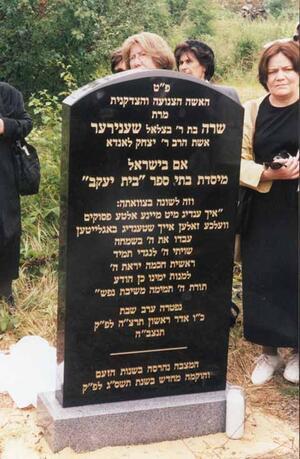
Sarah Schenirer was an unlikely revolutionary—a pious seamstress living in Poland. Yet it was this young woman who created Bais Ya'akov, the first educational system for Orthodox girls and a movement that continues to educate thousands of young women worldwide each year. In 2005, the seventieth anniversary of Sarah Schenirer's death, a group of women arranged for the restoration of her gravestone in the Cracow Jewish cemetery, which had been razed when the Plaszow concentration camp was built
Institution: Devorah Sandorfy Sabag, Jerusalem
After World War II, however, the world center of the movement shifted to Israel and North America, and some of revolutionary character of the interwar movement was domesticated. Girls’ Torah study was now understood as valuable not for its own sake, but because these girls would grow up to be pious wives and mothers. In the early years of the state of Israel, Bais Yaakov began to stress the significance of male Torah study and encourage graduates to seek mates who would “sit and learn” Talmud for years after marriage while their wives supported them. Bais Yaakov aided the construction of “the society of [male] learners” with its rapid growth, which enabled graduates to find employment as teachers. But with the education system reaching saturation, the question of women’s employment reemerged. Some schools—for instance in Haifa—were relatively open to preparing pupils for the Bagrut, the Ministry of Education matriculation examinations, in order to open doors for graduates to higher secular education; in more conservative communities, such as Jerusalem and Bnei Brak, however, Bais Yaakov does not prepare students for university. Similar economic stresses and rightward ideological shifts have produced a similar differentiation in Bais Yaakov schools elsewhere in the world, with some schools advertising their college-preparatory curriculum and others forbidding students from taking that path.
In 2005, the seventieth anniversary of Sarah Schenirer’s death, the Central Bais Yaakov of Jerusalem (known as “the Mercaz”) established an archival repository of documentation from the early years of the Bais Yaakov movement. While Bais Yaakov continues to grow and diversify, a core aspect of its identity continues to be the attachment to its founding figure and “mother.”
Despite these differences, the network of Bais Yaakov schools throughout the world has come to be associated with uncompromising standards of modest dress, passionate observance of Judaism, and intensive study of religious texts (with the Talmud, of course, excluded). In recent years, tensions have been felt between the Jews of European origin and their descendants, including most of North and South American Jewry.Ashkenazi and Descendants of the Jews who lived in Spain and Portugal before the explusion of 1492; primarily Jews of N. Africa, Italy, the Middle East and the Balkans.Sephardi ethnic elements in the schools in Israel, with the claim being made that the Sephardi pupils are less strict in their religious practice. Similar tensions exist between Hasidic and yeshivish families, generally over differing degrees of openness in dating and courtship patterns.
Baumel, Judith Tydor, and Jacob J. Schacter. “The Ninety-Three Bais Yaakov Girls of Cracow: History or Typology. In Reverence, Righteousness, and Rahamanut: Essays in Memory of Rabbi Dr. Leo Jung, edited by Jacob J. Schacter, Lanham, MD: Jason Aronson, 1992.
Benisch, Pearl. Carry Me in Your Heart: The Life and Legacy of Sarah Schenirer. New York: Feldheim Publishers, 2003.
Dansky, Miriam. Rebbetzin Grunfeld: The Life of Judith Grunfeld, Courageous Pioneer of the Bais Yaakov Movement and Jewish Rebirth. Rahway, NJ: Mesorah Publications, 1994.
Fuchs, Ilan. Jewish Women’s Torah Study: Orthodox Religious Education and Modernity. New York: Routledge, 2014.
Ginsparg Klein, Leslie. “‘No Candy Store, No Pizza Shops, No Maxi-Skirts, No Makeup’; Socializing Orthodox Jewish Girls through Schooling.” The Journal of the History of Childhood and Youth, 9, no. 1 (Winter 2016): 140-158.
Leibowitz, Rebbetzin Danielle S. with Devora Gliksman. Rebbetzin Vichna Kaplan: The Founder of the Bais Yaakov Movement in America. Brooklyn, NY: Keter Judaica, 2016.
Lisek, Joanna. “Orthodox Yiddishism in Beys Yakov Magazine. In the Context of Religious Jewish Feminism in Poland.” In Ashkenazim and Sephardim: A European Perspective, edited by Andrzej Katny, Isabela Olszewska, and Aleksandra Twardowska. Pieterlen and Bern: Peter Lang, 2013.
Manekin, Rachel. The Rebellion of the Daughters: Jewish Women Runaways in Habsburg Galicia. Princeton, NJ: Princeton University Press, 2020.
Oleszak, Agnieszka. “The Beit Ya’akov School in Kraków as an Encounter between East and West.” Polin: Studies in Polish Jewry, 23 (2011): 277-290.
Rosengarten, Sudy. Worlds Apart: The Birth of Bais Yaakov in America, A Personal Recollection. New York: Feldeim Publishers, 1992.
Rubin, Devora, comp. Daughters of Destiny: Women Who Revolutionized Jewish Life and Torah Education. Rahway, NJ: Mesorah Publications, 1988.
Seidman, Naomi. Sarah Schenirer and the Bais Yaakov Movement: A Revolution in the Name of Tradition. Liverpool: Littman Library of Jewish Civilization, 2019.
Weissman, Deborah. “Bais Ya’acov: A Historical Model for Jewish Feminists.” In The Jewish Woman: New Perspectives, edited by Elizabeth Koltun. New York: Schocken Books, 1976.
Weissman, Deborah R. “Bais Ya’acov, A Women’s Educational Movement in the Polish Jewish Community: A Case Study in Tradition and Modernity.” Master’s thesis, New York University, 1977.
Yafeh, Orit. “The Time in the Body: Cultural Construction of Femininity in Ultraorthodox Kindergartens for Girls.” Ethos, 35, no. 4 (December 2007): 516-553.
Zolty, Shoshana Pantel, “‘And All Your Children Shall Be Learned’: Women and the Study of Torah in Jewish Law and History. Lanham, MD: Jason Aronson, 1997.

